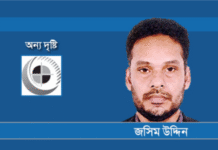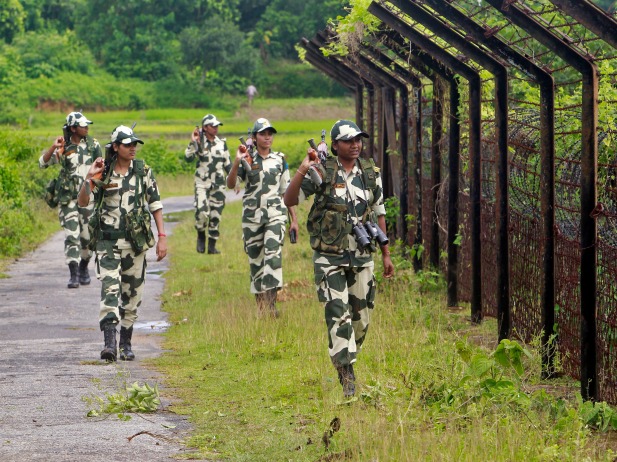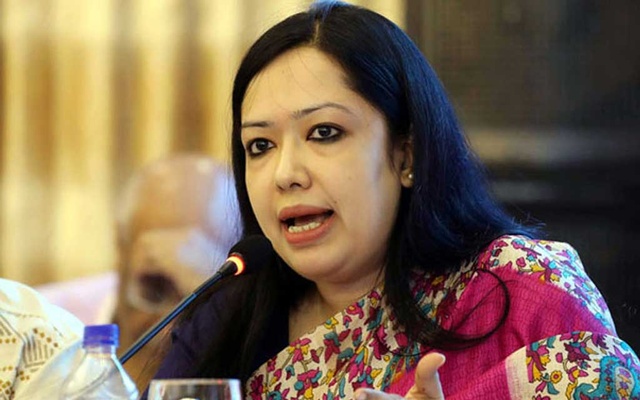
There is a grave in Babanpur, a village located in the west part of Pirganj, Rangpur. The grave is very near to the newly paved road, surrounded by fields where birds still chirp and the breeze still carries the scent of the rice fields.
A large signboard next to it reads: “Final resting place of Abu Sayed – the first martyr of the July 2024 anti-discrimination student movement.”
You wouldn’t need the signboard to know about what happened to Sayed. The soil there is tended carefully. Footsteps pause beside it, almost daily. Abu Sayed’s mother, Monowara Begum, walks past it more than she walks into her own room.
She still sleeps on her son’s old bed, under the same tin roof that creaks in the wind. “Every night,” she says, “I feel like he’ll come home and call my name.” Her eyes shine with unshed tears – not because the pain has faded, but because she’s long run out of new tears to shed.
The spark that lit a nation
It wasn’t supposed to be this way. Abu Sayed – the youngest of nine siblings, the only one to make it to the university – had dreams. Government service, financial freedom, and a life beyond the boundaries of rural hardship. That dream, he believed, began with reforming a quota system he saw as unjust.
He was one of the first organisers of the movement in Rangpur. His classmates at Begum Rokeya University recall him as quiet, driven, and fiercely idealistic.
On 16 July 2024, that idealism turned into martyrdom.
Videos from that day show a young man with his chest bare and arms spread wide, standing more than fifty feet away from a line of armed policemen. In one hand, he clutched a stick. In the other, defiance.
There was no threat in his posture, no aggression in his stance – just the stubborn will of a young man who is unwilling to yield. Before that, protesters were brutally beaten by the police. Yet, even though the other protesters left the spot, he remained unwavering.
And then, the police began to shoot. Birdshots from a shotgun were used, a weapon specifically banned by the Geneva Convention.
Once. Twice. Thrice.
The world bore witness to the death that jolted the nation upright in rebellion.
The water was muddied
In the days that followed, the state rushed to manage the narrative. What was plainly visible to millions on camera – a young man gunned down at a distance – was clouded in official contradiction.
The then prime minister claimed Abu Sayed had died from injuries caused by brickbats hurled by protesters. She suggested a delayed hospital visit, claimed the police only had rubber bullets, or blamed “unidentified agitators.” The then Minister of State for Information and Broadcasting, Mohammad A Arafat, even had the audacity to insinuate that Abu Sayed was under the influence of a drug.
The first autopsy at Rangpur Medical College said otherwise – that he was killed by shotgun pellets. But that report was never meant to be revealed. Dr Rajibul Islam, the forensic physician, was pressured, threatened, and forced to alter his findings six times. Each version blurred the truth a little more.
One report said “head injuries.” Another cited “blood clots.” Eventually, all versions converged on a vagueness that obscured what every viewer of that viral video already knew.
Even the FIR filed by police claimed Abu Sayed was not a victim of police action, but of a clash involving 2,000–3,000 unidentified miscreants.
It was, in every sense of the word, a cover-up.
Truth, resurrected
The facade, however, would not hold. After the fall of Hasina, the case reopened, and it became clear that it was the police who killed Abu Sayed.
Later, a forensic investigation led by Drik Picture Library and the UK-based Forensic Architecture used satellite imagery, heat maps, interviews, and video analysis to reconstruct what happened.
Their conclusion was unequivocal: Abu Sayed was deliberately shot with birdshot – an inappropriate and illegal munition for crowd control – from a distance of precisely 14.22 metres.
The verdict: Two policemen fired. One young man died.
Their evidence directly contradicted the prime minister’s claims. It revealed a coordinated attempt not just to kill, but to erase – the truth, the context, and the accountability.
Even the United Nations, in a rare public statement, confirmed what the people already knew: this was an extrajudicial killing. The OHCHR labelled it a reckless use of force, a gross violation of human rights.
Justice yet to be served
Back in Babanpur, Monowara Begum keeps vigil.
“I do not want my son’s blood to go to waste,” Monowara said. “I want justice for his murder. Only then will my heart find peace. They are using my son’s name for politics – we do not want that. We want justice.
“The cause for which my son gave his life has still not been realised. His sacrifice has been in vain. When will justice come? The country is still in turmoil.”
One year has passed since Abu Sayed was killed, yet his family remains dissatisfied with the progress in the investigation. His father, Mokbul Hossain, complained that those responsible for the murder still roam freely and hold jobs.
“Some people have been detained, but many are only making empty promises. We do not know when justice will be served,” he said.
For Monowara, each day begins and ends at her son’s grave. She speaks to it as if he is still there, not just under the earth, but somewhere nearby, watching. There is no peace in this kind of grief; only the ache intensifies.
On 18 August last year, Ramzan Ali, the elder brother of Abu Sayed, filed a case against 17 individuals, including the former Inspector General of Police (IGP) Chowdhury Abdullah Al-Mamun, former Deputy Inspector General (DIG) of Rangpur Range Abdul Baten, and former Commissioner of Rangpur Metropolitan Police Md Moniruzzaman, over the killing of Abu Sayed.
Two murder cases have been filed in connection with Abu Sayed’s death – one by his elder brother and the other by the police. On 17 July, the police lodged a case with the Tajhat Police Station over the incident. Both cases are currently ongoing in Rangpur. In addition, a separate murder case has also been filed with the International Crimes Tribunal.
One year on, the case has barely moved. Only a handful of lower-ranking individuals have been detained.
The face of the uprising
Abu Sayed became a face – not because he sought it, but because he did not flinch.
His death turned the tide. The quota protests became something bigger – a movement against fear, against impunity, against a regime that had forgotten how to listen. Abu Sayed’s image – chest open, arms stretched – became the emblem of courage. His blood turned into the ink of rebellion. His death was not just mourned; it was reverberated through chants, marches, and memories carried forward by thousands.
In Dhaka, students uttered his name in Shahbag. In Chattogram, protesters carried his photo on banners. Even the diaspora joined in. “Justice for Abu Sayed,” they chanted from streets as far away as New York and London. Even today, the slogan ‘Abu Sayed Mugdho, Shes hoy ni juddho’ (‘Abu Sayed Mugdho, the war is not over yet’) is the rallying cry for pro-Bangladeshi forces.
Legacy still unfolding
In a symbolic gesture, the interim government has since declared 16 July as Shaheed Abu Sayed Day. It is now one of three national days commemorating the July Uprising. Begum Rokeya University has held memorials, named scholarships in his honour, and dedicated a student debate championship to his ideals.
But perhaps his truest legacy lies not in memorials, nor in national days, but in the courage he planted in others.
Young men and women – many younger than Abu Sayed himself – continue to stand, march, and demand the dignity that he died for. During the uprising, we saw countless men spread their arms in defiance, chanting – Shoot me, I bare my chest open!
In his final Facebook post, shared just a day before his death, Abu Sayed uploaded an image of Professor Shamsuzzoha, another martyr of the student movement of 1969. His caption read: “Sir, we desperately need you right now. Your legacy is our inspiration.”
There are graves, and there are beginnings. Sometimes, they are the same thing. In death, Abu Sayed became the icon of the uprising.
On that small plot of soil in Babanpur, where the wind sighs through tin and dust, a young man lies buried. But from him has risen something larger – an unkillable idea, because ideas are bulletproof.









